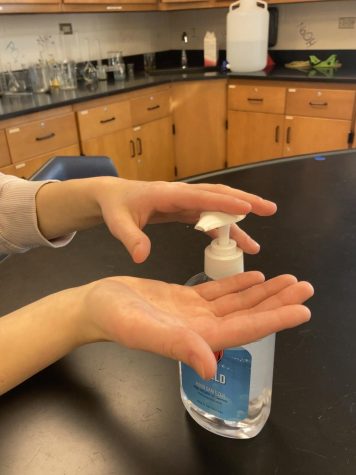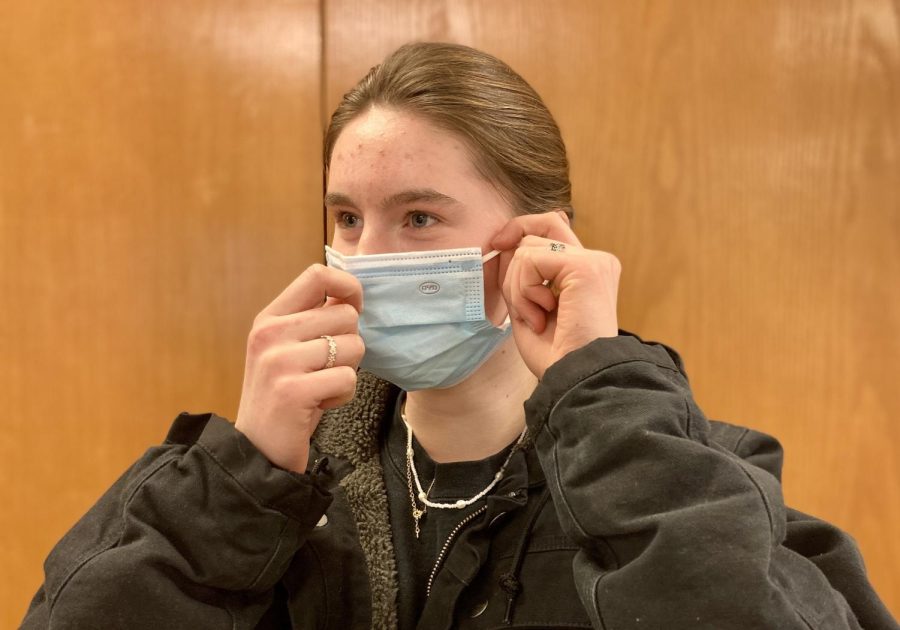New COVID-19 Protocols Shorten Quarantine and Isolation Periods
Senior Veronika Hokrova adjusts her mask.
January 14, 2022
On Friday, Jan. 7, the Illinois Department of Public Health, Illinois State Board of Education and Kane County Health Department adopted new CDC guidelines regarding COVID-19 protocols in school in an attempt to reduce the number of isolation and quarantine days for students.
COVID-19 numbers have been increasing recently, keeping students at home. With no remote learning option, many of these students come back to school and find that they have fallen behind in their classes.
As of now, the new guidelines that the CDC, Illinois Department of Public Health, Illinois State Board of Education and Kane County Health Department implemented are reducing the quarantine and isolation period to five days.
“At this point in time, quarantine and isolation are the same amount of time, which is really different, because before, isolation started at the day of symptoms: 10 days. And quarantine was day of exposure: 14 days,” said St. Charles North school nurse Amy Boynton.
Quarantine and isolation may sound like the same thing; however, they refer to two completely different processes. Quarantine is if a person is in close contact with someone who tested positive with COVID-19. Students start the five-day quarantine after the day that the symptoms first appear for the student who tested positive. If a student is tested, and they do test positive, the test must be within 48 hours of your symptoms. Isolation, however, occurs if a student, themself, tested positive.
The test itself can be a rapid and doesn’t need to be a PCR unless there is an outbreak. Students can do the rapid test at home or at a local testing center. SHIELD testing, which is offered at school, is an example of a PCR test. It uses saliva to detect the virus’ genetic material. SHIELD testing is offered weekly and a student can sign up for SHIELD testing by registering with this link. The SHIELD test is a test-to-stay monitoring tool that the nurses use in order to determine if a student who is a close contact can stay in school. Results are received the following day of the test. If a student is symptomatic and they utilize the SHIELD testing, they are not allowed to be in school until their results come back as negative. Once they receive that negative, they are allowed to return.
Say a student starts getting symptoms on a Monday, but they still go to school, even though they should not, and don’t get a test until the following Sunday. If they tested positive, they would have to start their isolation period from that day of the positive test and return to school after the five days were up. But, if they were symptomatic on that Sunday, then they would go back 48 hours prior to the test and count five days from that Friday.
“Now, if you were COVID positive, but you’ve completed your isolation, you really have kind of a ‘Get Out of Jail Free period’ for 90 days, because your body can remain positive for that extended period of time,” said Boynton.
If the student had already had COVID-19 earlier in the year, but they were symptomatic in between a 90-day period, a test is not recommended as they may be able to still test positive because the proteins can continue to hang around in your body for that extended period of time, as Boynton explained.

In addition, there are also new guidelines that were implemented by the CDC that came with the addition of the booster shot. There are differences in requirements for both staff and students.
“Ages 18 and older, which would be staff who have received all the recommended vaccines, including boosters, quarantine is not required. Wear a mask around others and test on day five if possible, not required,” explained Boynton.
An email was sent out to teachers that said if they were fully vaccinated with the recommended two doses of the vaccine, and they were in close contact, they do not have to quarantine, but have to monitor unless they develop symptoms. Furthermore, they are also allowed to be in the building without the booster. Staff members, along with students, who are not vaccinated, do have to quarantine. This is where contact tracing comes in.
If a student tests positive for COVID-19, the administrators go to the teachers and tell them that a student in their class has tested positive. However, they do not give the name of the student. Instead, they ask that teacher if everyone in their class was wearing their mask properly and if they were all three feet apart from each other. If that teacher says that there are students who were not wearing their masks correctly and were three feet or less from each other, then those students are considered a close contact by the administrators.
Additionally, in the cafeteria, students have to be six feet apart because they aren’t wearing a mask. But, when they do have a mask on they can be three feet apart. This is how the classrooms are set up, with the desks three feet apart. Theoretically, a person shouldn’t get sick from school because it is a controlled environment if a student is following the rules and wears their mask correctly.
“So that’s why the mask is so important. The mask gives us that ability to be closer together to one another than without the mask,” said Boynton.



